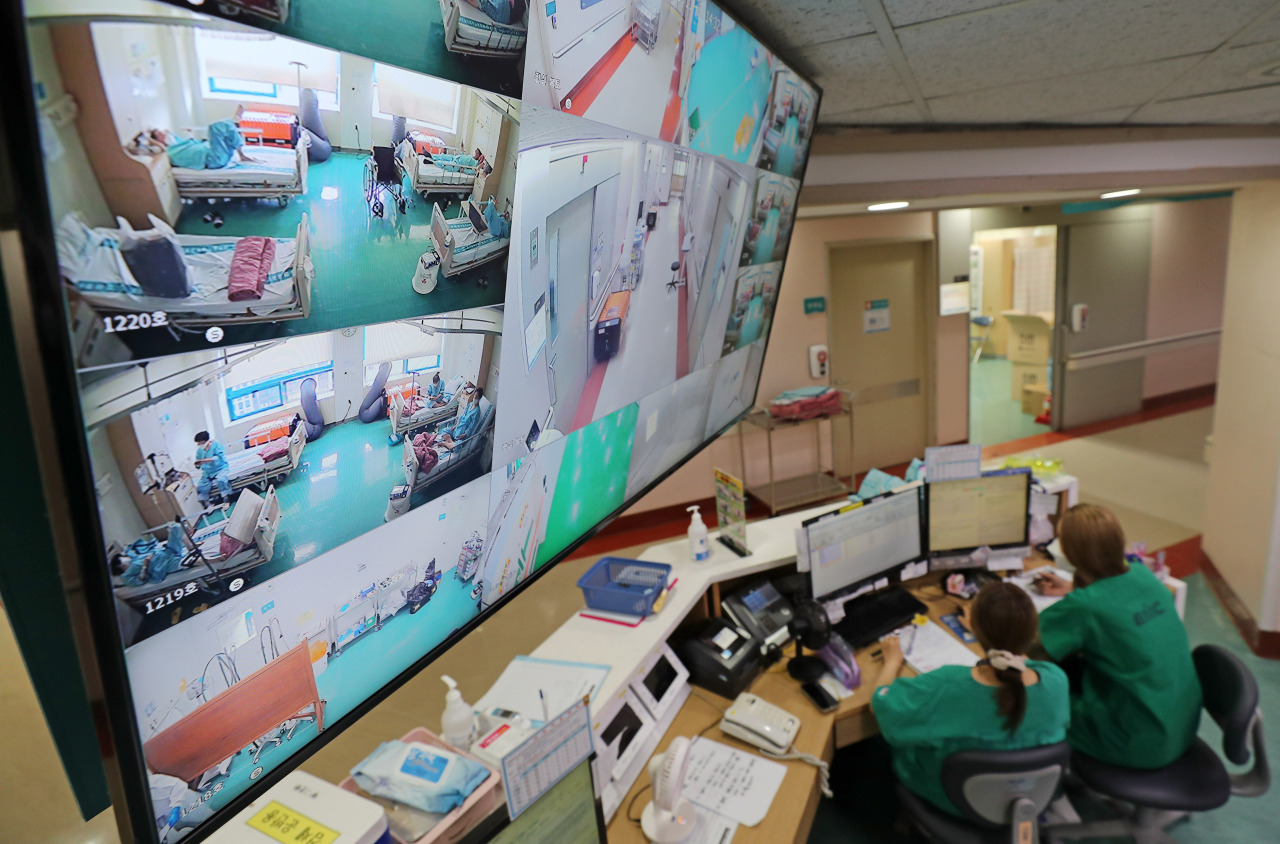
Health care workers monitor patients in isolcation care words at a hospital in Daejeon on Monday. (Yonhap)
South Korea’s decision to make at-home care the default for all COVID-19 patients could cost savable lives, experts warn, as the country adheres to route back to normal amid the largest surge since the pandemic began.
On Monday, the government announced that all patients will be treated at home unless they get very sick, without bringing back measures to slow the spread.
With Monday’s announcement, Korea made its departure from one of the three pillars of its touted pandemic success formula known as “3T” -- test, trace and treat -- official. Contact tracing and testing, too, were downscaled in line with the Nov. 1 phased return to normal to lift the administrative burdens.
The decision to keep as many COVID-19 patients as possible at home comes as hospitals are running out of beds, especially in intensive care wards. Nationwide, 78 percent of intensive care beds were occupied by Monday midnight, clearly exceeding the threshold of 75 percent for initiating an emergency response.
In its latest weekly situational assessment, the Korea Disease Control and Prevention Agency said the state of the COVID-19 outbreak all across the country was “very dangerous,” warning that hospitals were nearing maximum capacity.
And yet Korea remains committed to staying open, President Moon Jae-in stressed in his address Monday. “There can be no turning back in our journey toward normal life,” he said. The fallout from this move will land most heavily on patients, experts say.
Infectious disease specialist Dr. Eom Joong-sik at Gachon University Medical Center in Incheon near Seoul pointed out during a phone call with The Korea Herald that Korea was jeopardizing the safety of the most vulnerable populations with the “across-the-board home care scheme.”
“I’m not against having home care as option for younger patients without risk factors. But for patients in their 50s and 60s, and those who are even older, it’s a different story,” he said. In a previous phone call, Eom called Seoul’s Nov. 23 policy to extend home recovery to older patients in their 70s and above one that “risks deaths.”
Onetime Korea Centers for Disease Control and Prevention Agency director Dr. Jung Ki-suck said COVID-19 was still too deadly a disease to be letting patients to recover from home, regardless of how old they might be.
“COVID-19 still kills five to seven out of every 1,000 patients,” he said, explaining, that meant that many of them were going to be at risk of death as they isolate outside the hospital. In November so far the case fatality rate climbed past 0.9 percent -- the highest since the vaccination campaign began earlier this year.
“It’s almost insulting (to send them home) when there are beds we can still mobilize,” said the former KCDC chief. Community treatment centers around the country still had more than 6,000 vacant beds as of Monday afternoon, according to the ministry update.
While patients under home isolation are supposed to be promptly moved to health care facilities once their symptoms worsen, around 1,000 patients were waiting to be assigned a bed for longer than 24 hours as of Monday, according to the ministry.
Jung, who is a respiratory disease specialist, said putting non-health care professionals in charge of mobile monitoring and deciding when a patient at home should be admitted was “flawed from its design.”
“I’ve seen pneumonia patients my whole life. You just can’t tell how a patient might be doing over the phone, especially if you are a non-professional,” he said.
The timing of implementing home care was also unfortunate, he said. “We could have waited until oral pills become available in the country, which is only a couple of months away.”
Although the government has proposed expanding home care as a means to alleviate the burden on critical care services, respiratory disease specialist Dr. Park Sung-hoon of Hallym University Sacred Heart Hospital’s Park said he was “skeptical.” Park, who is at the hospital’s ECMO center treating the sickest COVID-19 patients, said home care “is no alternative to the ICU.”
“Some of the patients at home are still going to fall severely ill.”
Eom of Gachon University Medical Center said hospital bed shortages could not be eased unless fewer people get infected in the first place. He pointed out that “nothing about Monday’s announcements entailed measures for bringing infection rates down.” Even if social distancing and other similar interventions were to be implemented now, he said, it would take at least two to three weeks for them to show effect.
Dr. Jung Jae-hun, a preventive medicine specialist advising the prime minister on COVID-19 policies, agreed that with the measures being put forth now it would be “impossible to contain the current surge.”
“We’re not pursuing efforts to slow the spread, which is the essence of the return to normal scheme,” he said.
The president urged people to receive booster vaccinations to beat the surge in infections, but most people under 60 in Korea have just gotten their second dose in the past couple of months. The mandatory wait time for a third dose is five months.
Meanwhile, Son Young-rae, spokesperson for the Ministry of Health and Welfare, told reporters in a closed-door briefing Tuesday that “patients can be forced to stay home against their will, or that of their guardians or family members” as COVID-19 hospitals were overly crowded.
Another infectious disease expert, Dr. Kim Woo-joo of Korea University, said by prescribing home recovery to patients across the board without taking the steps to tame the surge, it will be “patients who take the hardest fall.”
By Kim Arin (
arin@heraldcorp.com)






